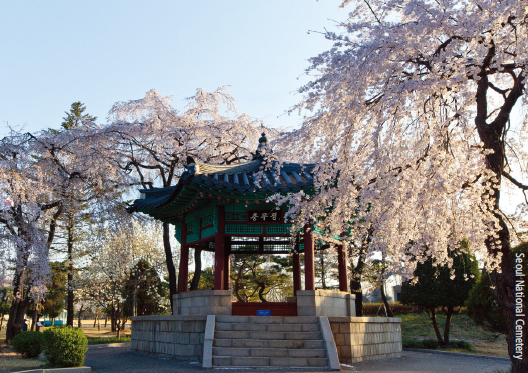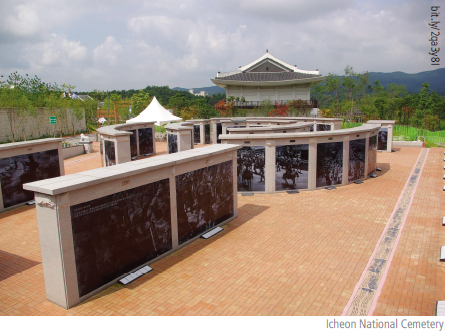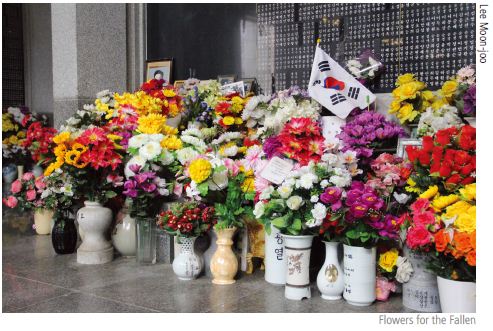
Since 2008, the Seoul National Cemetery has hosted an annual publicity event at the time when the weeping cherry blooms. This attracts a lot of visitors, but along with these visitors come several problems. Although the cemetery bans drinking and advises visitors not to lie on the ground, many still act as if they are in a festival, yelling and drinking. Some couples show affection in public, and children run around, occasionally knocking over vases. Parents often pitch tents on the lawn. Several rangers patrol the grounds, but controlling visitors has become more difficult. The reality is that people do not recognize the significance of the cemetery and treat it the same as they would any public park.
In January of 2017, staff experienced a new problem. Pokemon Go, a mobile game released that month, became a national craze. Visitors brought the game, which features an augment-reality and location-based service, to the cemetery, and some trespassed on the cemetery after it had closed, in order to catch a rare Pokemon. These trespassers were all caught and punished, but their behavior further demonstrates the lack of public awareness. However, perhaps we cannot blame them for their ignorance. A campaign for greater public awareness is needed, helping visitors understand this place and providing them with the means to show the highest respect and solemnity.
Korea’s Memorial Day is June 6, one of the times when the cemetery greets the largest number of visitors. If we visit the National Cemetery at this time, we need to know more about the place and the basic protocol for visiting.

The cemetery began during the Korean War as a place to bury fallen soldiers. As the number of interred soldiers grew, the military decided to dedicate the area as a formal cemetery and memorial. As time passed, after the Korean War, the cemetery extended its function to include other public servants, such as police officers and those who have made remarkable contributions to national development, then broadened further to include firefighters and those whom the Korean government has designated as righteous or noble citizens. As the original cemetery filled, the Daejeon National Cemetery was constructed in 1985. Thus, the primary site is now located in two places, Seoul and Daejeon.
Moreover, there are now additional National Cemetery sites, each fulfilling a different function. For those who died as soldiers, but could not be buried at the sites in Seoul or Daejeon, there are four cemeteries, one each at Yeongcheon, Imsil, Sancheong, and Icheon. These four sites, along with the Daejeon site, were once under the care of the Korea Veterans’ Association, a private organization, but they are all currently maintained by the government Ministry of Patriots’ and Veterans’ Affairs. The original cemetery in Seoul is under the care of the Ministry of National Defense.
Finally, also administered by the Ministry of Patriots’ and Veterans’ Affairs, there are cemeteries to honor those who died during the democratic movement of the sixties, seventies, and eighties, with sites named to commemorate major dates: April 19, 1960; May 18, 1979; and March 15, 1980.
In English, these sites are all designated as national cemeteries, but in Korean, they are categorized. The Seoul and Daejeon cemeteries are known as Hyeonchungwon. The cemeteries in Yeongcheon, Imsil, Sancheong, and Icheon are known as Hogugwon. Lastly, the three sites honoring the victims of the democratic movement are called Minjumyoji. Although all patriots are treated with the same respect at burial, the site where they are buried depends on where they fit in the government’s categories.

Focusing on the Seoul National Cemetery, most of the graves are tombs for military personnel, and these are located along both sides of Hyeonchoung-cheon, a stream that crosses the cemetery. In the middle of the park, there are graves for citizens of national merit, presidents, and other graves for patriots who died during the Japanese colonial period. Other than these, graves for generals, foreign patriots, and police officers are located throughout the cemetery. Also, some formal events are held at the Memorial Gate and Memorial Tower, in the middle of the cemetery.
The cemetery preserves a well-developed natural environment. Unlike other urban forests, it has sustainable vegetation, with a well-mixed stand forest and a low percentage of acacia trees. Nearly 200 kinds of plants thrive here, including over 100 species of trees and 30 native species. Because the cemetery bans planting or harvesting, this place provides sanctuary for many species of birds and other animals.
Changes in the National Cemetery
Since the Seoul National Cemetery is located in the center of the urban area, the Ministry of National Defense makes great effort to provide public information on these features, including an official blog to communicate with citizens. Through the blog, the ministry tries to promote the significance of the cemetery. They announce opportunities for volunteer work, provide guided tours, and organize memorial events. Usually, teenagers who live in Seoul would have heard about the opportunities to volunteer since most of them need a certain number of volunteer hours to graduate from high school. Some of the volunteer programs do not directly educate these students about the value of the cemeteries, but they may at least make the students aware of the cemeteries’ existence. Through these programs, the ministries aim to instill some awareness into future generations, as well.
In its public relations, the cemetery’s administration describes the area not only as a cemetery, but also as an urban park, and it highlights the park-like characteristics. On their blog, they promote events that many readers would associate more with urban parks than with national cemeteries, such as essay contests, cartoon competitions, photo contests, and seasonal festivals. The festival will be the most noticeable, largest event, exceeded only by Memorial Day ceremonies. These events appeal to citizens by adding value as an urban park. In the past, most of the visitors to the cemetery were relatives of patriots, or people who felt a duty to honor the lives of the fallen. Politicians will often visit gravesites, as well, during campaigns. However, as each festival approaches, the number of public visitors increases significantly. With appealing programs such as the contests, or a walking event coordinated in collaboration with nearby Dongjak health center, and the beautiful views, the cemetery increasingly attracts the public as a cultural space.
In Korea, it is often for mourners to pour alcohol on a grave. Ancestors believed that the pouring of alcohol will call the soul of the departed to the grave and invite the soul to eat the food they the mourners have prepared. This is one way descendants show their filial duty toward their dead ancestors, especially their parents. Sometimes they burn incense so that the soul can ride on the smoke. However, Seoul National Cemetery bans alcohol and burning of incense for safety reasons; consumption of alcohol is prohibited at all times.

If the public used to think of the National Cemetery as a difficult place to visit, these programs may have improved public access; but this access has also caused some problems. Discourteous visitors kick and climb trees to take photos. Some even break twigs just to take pictures. Others leave their trash where they have stayed. Drunk people make noise and cause others to raise their eyebrows. Patrols do exist, but too few in number. At worst, some visitors actually cause distress to the cemetery and funeral attendees. In the public forum on the cemetery’s website, many of the posts are complaints about the behavior of visitors, rather than the positive feedback that the administration would like to see.
One writer complained, for example, “The Cemetery is very beautiful, and the festival deserves praise. It is great that so many people attend and enjoy the mood of spring. However, people drinking, singing, and dancing as if they are at a general festival is a clear problem. This place should be a reverent place where people pay tribute to the spirit of those patriots who gave up their lives for our country. The difficulty of control [that the administration cites] seems like an excuse to me.” The writer added that he urges the cemetery to implement new approaches to management rather than merely reminding the public to behave with civility. The administration’s reply to this poster’s complaint may reveal the very attitude that the poster is pointing out: during the spring festival there is an announcement, the administration said, reminding visitors that “this is the place where people cherish the memory of the deceased, so please remain reverent and solemn.”
According to Dong-A ilbo, as funeral guests observe the behavior of some visitors, they may sense a gap between the past and present, where modern sensibilities have detracted from the traditions of the cemetery. Many of them feel the need for regulations over cemetery use, as behavior often contradicts the emotions associated with any cemetery space. These conflicts mainly started in late 2000s, after the privatization of the National Cemeteries. In January 2006, the National Cemetery changed affiliation; the Seoul National Cemetery became an agency under the Ministry of National Defense, while the others became a part of the Ministry of Patriots’ and Veterans’ Affairs. Since then, the agencies responsible have tried to improve publicity and raise public awareness. One person who visits the cemetery frequently said that there seems to be an increase in reckless, noisy visitors since privatization, and added that the security patrols should show more concern in their work.

One example of effective management over a public cemetery may be seen at Arlington National Cemetery in the United States, which is known as one of the most famous and best-organized cemeteries in the world, heavily visited by tourists. There are several points that make this cemetery function well. When you see the website of the cemetery, there is a tab called “Policies and Public Notices.” There, the public can view the many specific policies and restrictions governing conduct, including not only protocols for visitors with specific purposes, but also simple rules for tourists. Likewise, a similar document on the website of the Korean National Cemeteries should provide clear regulations. Given the lack of clarity and organization in the information that the administration does provide, visitors often ask about rules and regulations on the public forum, as if the forum is an FAQ document. The administration should clearly distinguish its documents containing policies for conduct from the public forum.
Another example of right behavior is provided by the citizens of the U.S. who visit the Arlington Cemetery. Visitors will sometimes police the cemetery themselves, even if there is no administration present. For example, a recent news item showed a woman who took a disrespectful photo with a gesture that many would consider abusive in the cemetery; she posted the photo on Facebook. Soon, the public condemned her photograph, and eventually resulted in the woman losing her job. Although this was an extreme, unusual example, it is telling that many people felt so angry at the woman’s behavior. Likewise, the public itself can act before the government completes its guidelines. Most people know if the behavior they witness is inappropriate, and many will respond. If not, conflicts will continue even with the policies.

Lee Moon-joo
dia7moon@uos.ac.kr

